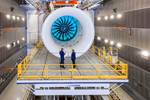GKN Aerospace expands aeroengines facility in Sweden
Digitized fabrication processes and enhanced production capacity to meet growing ramp-up for aeroengines, composites-intensive and otherwise.
GKN Aerospace (Redditch, U.K.) has plans to increase the capacity and efficiency of its aeroengines manufacturing facility in Trollhättan, Sweden. A new 5,000-square-meter production area will embrace the latest digital factory processes when it is fully operational in 2026, supporting the ongoing global aerospace industry ramp-up.
The investment adds capacity with additional automation, robotics and digital technologies. This will enable GKN Aerospace to drive up productivity, improve quality and reduce industry lead times of its engine systems and major structural components, such as the GEnX, GTF and Trent XWB; GKN says that currently, its aeroengine backlog is as much as 9 years.
“We are seeing record order backlogs and strong growth potential across the industry, and this expansion enables us to support our customers and seize that opportunity,” adds Joakim Andersson, president of GKN Aerospace’s Engine business.
This expansion follows a January announcement that GKN Aerospace is also establishing an Additive Fabrication Centre of Excellence in Trollhättan, as it positions the Engines business for further growth.
Related Content
-
Plant tour: Joby Aviation, Marina, Calif., U.S.
As the advanced air mobility market begins to take shape, market leader Joby Aviation works to industrialize composites manufacturing for its first-generation, composites-intensive, all-electric air taxi.
-
Combining multifunctional thermoplastic composites, additive manufacturing for next-gen airframe structures
The DOMMINIO project combines AFP with 3D printed gyroid cores, embedded SHM sensors and smart materials for induction-driven disassembly of parts at end of life.
-
Next-generation airship design enabled by modern composites
LTA Research’s proof-of-concept Pathfinder 1 modernizes a fully rigid airship design with a largely carbon fiber composite frame. R&D has already begun on higher volume, more automated manufacturing for the future.













